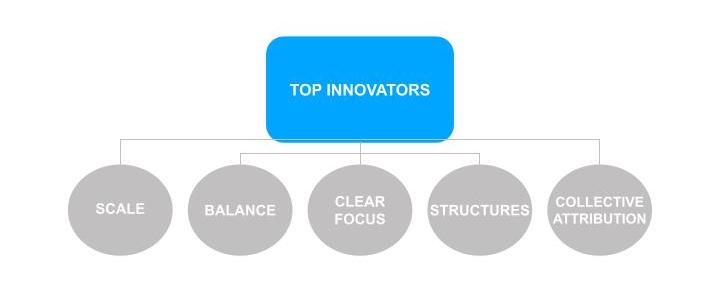7 Ways to Build a Culture of Innovation Through IT Leadership

How associations can empower IT leaders to bring innovation to life
Managing membership, improving engagement, and driving dues and non-dues revenue all increasingly hinge on your organization’s ability to use cutting-edge technology.
In order to digitally mature on a continual basis and outperform the growing competition, technology leaders have moved out of the silos and onto the executive leadership team. Today IT leaders are essential visionaries propelling modern professional associations forward.
In this article, we’ll look into the integral role of IT leadership and innovation in maintaining business continuity and sustainable growth in the digital age. We’ll discuss the IT leadership roles, skills, and mindsets you need to succeed in innovation based on our 20+ years of experience partnering with mission-driven organizations on their transformative journeys.
Here are the seven steps your association can take to build your IT leadership capabilities in order to achieve a culture of innovation and continuous process improvement.
1. Get the right IT leadership roles in place
Chief Information Officers (CIO) and Information Technology (IT) directors are becoming more and more vital to the innovative potential and longevity of associations.
These two leadership roles work in conjunction to oversee an organization’s IT performance. The key difference is that the CIO is strategically focused, and the IT director is operationally focused.
Simply put, the CIO, whether virtual or in-house, is the driving force behind your IT’s transformational direction. The ultimate goal of a CIO is to advance the mission of an organization through technology and digital transformation.
The CIO role is fairly new within associations. Do you need to get on board?
IT directors, on the other hand, are tactical and managerial. They’re there to “supervise” daily IT operations and ensure everything moves forward smoothly.
The ongoing evolution of the digital landscape continues to define the integral role that both IT leaders play in today’s organization. And as organizations become more digitally mature, these specialized IT leadership positions become more complex and significant.
2. Ensure IT leaders have the hard AND soft skills
At a very high level, successful CIO candidates need excellent strategic planning and leadership skills. These executives must be able to see the big picture, adapt technology and processes to maximize organization-wide success, and communicate technical complexities to fellow C-suite leaders.
CIOs need a depth of business experience in order to effectively allocate an IT budget, ensure accountability, and change behaviors and company culture as needed to create a data-driven organization.
| Key Skills of a Successful CIO | Key Skills of a Successful IT Director |
| Range of business abilities and soft skills | Range of hard and soft skills |
| Strategic, transformational thinking | Proficiency in computer systems, networks, security, telecommunications, databases, and storage systems |
| Strategic communication and the ability to translate tech jargon into digestible language for a non-technical audience | Ability to manage and prioritize projects and value-added initiatives |
| Interpersonal communication, emotional intelligence, and intuition | Availability, capacity, performance, and infrastructure lifecycle management |
| Change management and adaptability | Problem-solving and analytical skills |
| Vendor management | Forecasting and budgeting |
| High accountability and transparency | Motivating and deploying IT staff |
| Team development | Team management |
3. Hire Differently
The hiring process and skills necessary for success are fundamentally different in nature for these IT leadership positions.
Experience and “hard” technical skills are important when hiring IT directors. But when hiring a CIO or bringing on virtual CIO services, you want to focus even more on their soft skills.
Turn your IT team into a powerhouse that drives results.
Skills such as change management, transformational thinking, and creativity are hard to find. But these soft skills are critical to bringing innovation to life in your association. For example, imagining and implementing new revenue streams for associations and turning member data into profit requires soft skills.
So, ask CIO candidates about past innovation projects and how these advancements were connected to the mission of an organization.
Of course, you want someone who fits your organizational culture, but you also want IT leaders who will help your association shift to a culture of innovation.
Ensure your CIO prospects are prepared to do what’s necessary to ‘pivot’ when necessary; turning small failures in the learning that creates big wins. Doing so will allow your association to build up the innovation processes and culture necessary to achieve measurable progress.
You also want a CIO who is a true “mover and shaker.” Whether virtual or full-time, your CIO needs to know your organization inside and out and take intentional action. So, during the interview, ask them what they would do during the first 100 days and how they would measure progress.
4. The CIO should focus on these 3 change initiatives
Processes matter immensely, but some processes should be delegated by the CIO to the IT director or manager. For example, IT ops metrics and IT Infrastructure Library (ITIL) framework should be delegated so that the CIO can focus on innovation initiatives.
Establish clear ownership of core IT processes.
Here are the change initiatives and processes where the CIO should put their skin in the game to set your organization up for high innovation performance:
- Fixing the service desk - IT’s relationship with the rest of the business starts and stops at the help/service desk. IT’s reputation and successful integration with the rest of the business depends on the performance of the IT service desk.
- Agile strategy and execution - IT today is an integral part of achieving intentional business change. Adopting and refining an agile operating model can transform you into an adaptable, growth-oriented organization that is capable of thriving in any condition or circumstance. It also helps alleviate organizational challenges such as unclear accountabilities.
- IT architecture management - CIOs should oversee your IT architecture. Finding ways to achieve healthy, innovative, and secure architecture, and communicating its importance to executive leadership should be top priorities. IT innovation and information security should be folded into this IT architecture practice.
5. Understand the Innovation Maturity Matrix
Making continual transformation a reality for your association requires IT leaders to have a deep practical understanding of the innovation maturity matrix. This model allows you to:
- identify the current innovation capabilities of your organization.
- create a roadmap to mature your innovation performance and processes.
The traditional maturity matrix depicts different levels of innovation potential. The scale of maturity starts at a chaotic or non-existent stage, and proceeds to a reactive stage, then proactive, and finally maturing to the sweet spot of continuous process improvement.
However, the maturity of innovation capabilities isn’t the only differentiating factor between organizations that succeed in innovation and those that don’t. Virtually every top innovator undergoing continuous process improvement seems to have five main elements in place.
Five success factors of highly innovative organization

1. Scale
The first point is to understand that organizations with a high level of innovation maturity consider innovation efforts to be “business as usual.” Innovation happens on all levels and in every department virtually all the time. This transformational process is iterative, intentional, and deeply embedded in the company culture: the culture of innovation.
2. Balance
Great innovation performance requires a healthy balance of incremental and disruptive innovation capabilities. Highly innovative organizations continuously invest in transformative initiatives while also continuing to improve the existing business.
This is why IT leadership is so critical in the shift to an innovation culture. IT leaders are the innovation leaders. Not only are they in charge of the innovation processes and performance, but they're also required to clearly communicate the rationale for the change. IT leadership is what keeps that balance and cultural change moving forward.
3. Clear Focus
The third factor is about understanding that change doesn't happen overnight. You have to gain momentum. Scoring some low-hanging fruits and “quick easy wins” in the beginning helps to garner buy-in and get everyone excited about the journey.
Maintaining this third factor requires you to have strong IT leadership, strategic focus and direction, and organization-wide alignment.
4. Structures
Top innovative organizations have different decision-making processes in place to systematically progress (or ditch) ideas. Such mature structures may allow you to test a small change on a limited sample, for example, before rolling it out on a larger scale.
It’s about identifying and progressing small improvements. In the end, ironing out these innovation structures enables smarter decisions and swifter progress.
5. Collective Attribution
Various cognitive and emotional dynamics underlie the success or failure of an organizational transformation—whether it’s a culture change, new technology, or IT process.
Namely, employee attributions or your staff’s reasoning behind a new tech adoption subsequently affects their expectations, attitudes, and engagement towards that change. These cognitive processes, in turn, shape the effectiveness of the innovation.
Handling these complexities requires IT leaders to address the intentionality behind each new change and finesse ways to create buy-in—from department to department, manager to employee. This is where those soft skills come into play and the ability to inspire an organization-wide spirit of progress and collective understanding of the vision.
IT leaders who can grasp the nuances of this innovation maturity matrix will empower a well-structured and well-balanced culture of innovation that’s coordinated and supported across your association, from the front desk to the board room.
6. Accept that innovation is iterative so fail forward
The single most important truth your IT leadership and entire executive team need to understand is that innovation is an iterative process – many proposed ideas and change initiatives will (and should) inevitably fail.
Really, failure is the origin of innovation. Or, as Honda's founder, Soichiro Honda, put it: "Success is 99% failure."
So lean into those flops, take the good, ruthlessly kill the bad, then execute again.
Organizations with strong innovative cultures view missteps and bombed ideas as learning opportunities. Failure is a sign of your creative intelligence and the out-of-the-box thought processes that birth all great cultures of innovation.
There are no shortcuts but rather obstacles that you must conquer one by one by making intentional changes through smart decision-making. It’s all about adapting a growth mindset and establishing those innovation structures and continuous process improvements discussed in #5 above.
It’s these gradual, systematic changes and roll-up-your-sleeves dedication that’ll accumulate overtime to drive your organization forward. So fail forward, systematically, in your journey towards becoming a top innovator.
7. Prioritize innovative thinking opportunities
Organizations that have a strong culture of innovation prioritize activities that spark creativity, collaboration, and original thinking. For example, idea challenges and design thinking workshops are great for sparking innovation.
You can also create dedicated areas that transition your IT leaders and/or entire IT staff out of their everyday working environment in order to disrupt their thinking and facilitate face-to-face interaction.
Such dedicated spaces and intentional activities allow you to weaponize innovative thinking and turn it into measurable progress towards your goals.
Now that you understand the basics of how you can create a culture of innovation through effective IT leadership, don’t miss out on our upcoming checklists, 18 CIO Interview Questions and 20 IT Director Interview Questions.



